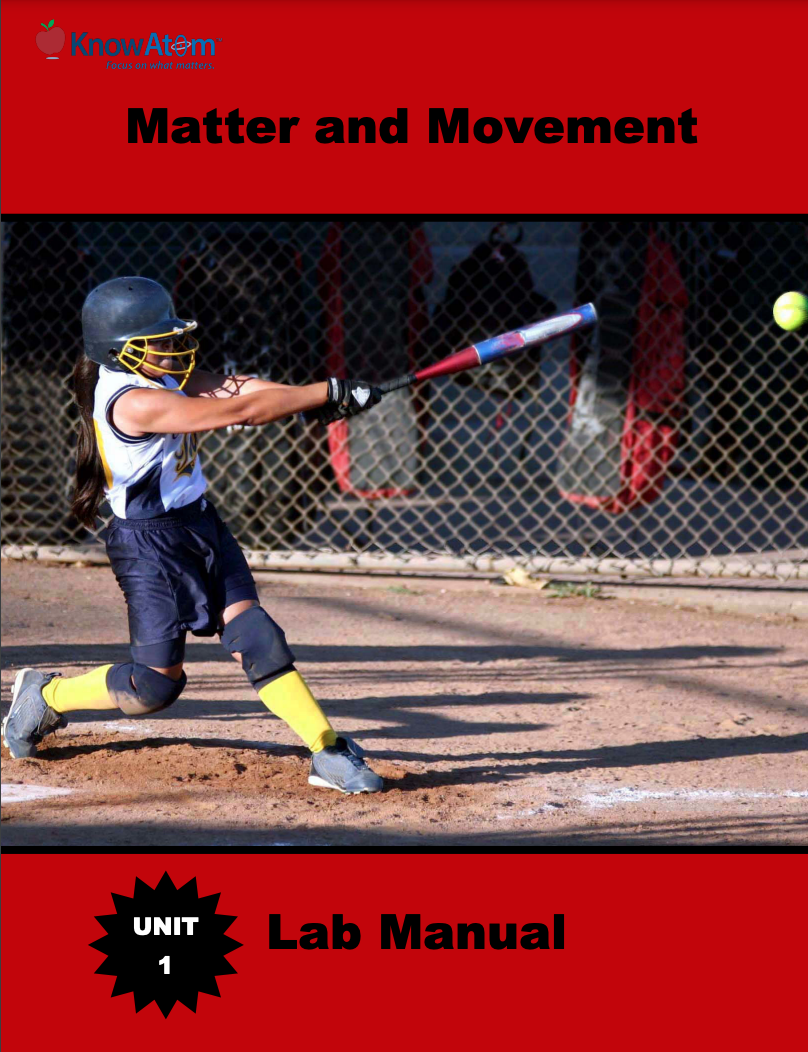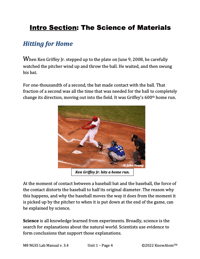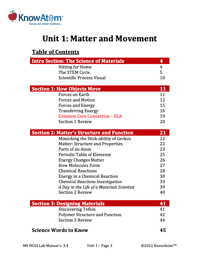The science background gives teachers more detailed information on the phenomena students explore. Here is an excerpt from the science background section on mass and motion.
Forces and Matter
The field of science that focuses on the relationship between the structure and properties of different materials is called materials science. Structure is the way in which parts are put together to form a whole. Materials scientists are interested in understanding the properties of existing materials, such as wool and cork, as well as in understanding how existing substances can be combined to form new materials with a specific set of properties that will allow them to be used in a particular way.
For example, the materials that make up the baseball, and the way that it is structured is very important because the ball experiences a tremendous amount of force during a game. The force applied by the batter isn’t the only force acting on the baseball. Forces are acting everywhere in the universe all the time. Even if you are standing still, you have many forces acting on you.
When you stand on Earth’s surface, gravity pulls you down toward the center of Earth. Gravity is the force of attraction between all matter. This means that gravity pulls objects together. It’s Earth’s gravity that keeps us and all objects on Earth from floating off into the atmosphere, and that pulls all objects thrown up in the air back to the ground. Gravity explains why all baseballs, no matter how hard they are hit, will eventually fall back to the ground.
The relationship between forces and motion was first described by a scientist called Sir Isaac Newton in the 1600s. Newton was fascinated by how things move. After much study, he realized that the motions of all objects follow the same three basic laws, which describe how forces cause objects to move.
Newton’s 1st Law
All objects on Earth are pulled on by the force of gravity. Newton observed that when all of the forces acting on an object are balanced, the object will not change its motion.
When the forces acting on an object are equal, they are balanced. This is Newton’s first law of motion, and it describes inertia. Inertia is the tendency for an object at rest to remain at rest and an object in motion to remain in motion unless acted upon by an outside force. Simply put, objects tend to keep doing what they’re doing. Stationary objects won’t start moving, and moving objects won’t stop moving unless the forces pushing or pulling on these objects become unbalanced. Unbalanced forces occur when two opposing forces acting on an object are not equal.
Think of a baseball game. The baseball won’t begin to move on its own. It will only start moving when something acts on it, such as when a player picks it up or throws it. The force of a player throwing the ball or the bat hitting the ball provides the unbalanced force that causes the ball’s motion to change.
In the same way, once the baseball is in motion, it will stay in motion until the forces acting on it become unbalanced. When the ball is in the air, it eventually falls down because of unbalanced forces. For example, gravity pulls down on the ball, eventually causing it to fall back to the ground.
Newton’s 2nd Law
Newton’s second law describes the relationship between the mass of an object, the magnitude of the force applied to it, and its resulting acceleration, or change in motion. This law can be written as an equation: “force = mass times acceleration.”
- Mass is the measure of the amount of matter that makes up an object or substance. It is measured in grams (g).
- Acceleration occurs whenever an unbalanced force acts on an object. It is the rate of change of an object’s velocity. (Velocity is the rate of change of an object’s position). Acceleration is measured in meters per second squared (m/s2).
Simply put, accelerations are changes in an object’s motion. Whenever an object speeds up, slows down, or changes direction, it accelerates. Speed is the rate at which an object covers distance in a period of time.
Newton’s second law says that when a force acts on an object and causes it to accelerate, its acceleration is directly proportional to the force and inversely proportional to its mass. Proportion is the relationship between things, as to size, quantity, or number.
In a directly proportional relationship, when one variable increases, the other variable increases. This means that the greater the force that is applied to an object of a given mass, the more the object will accelerate.
In an inversely proportional relationship, when one variable increases, the other decreases. The greater the mass of an object, the less it will accelerate when the same amount of force is applied.
Newton’s 3rd Law
Newton’s third law is the action-reaction law. This law states that every force occurs as one member of an action-reaction pair of forces. Action-reaction pairs occur whenever two objects come into contact with each other. For every action, there is an equal and opposite reaction. In other words, the two forces point in opposite directions but have the same magnitudes.
You are experiencing action-reaction forces right now. Remember that gravity is constantly pulling down on you. In reaction to the force of gravity pulling down, the ground has its own force that pushes back up with the same amount of force. This keeps you from sinking into the ground.
If the ground did not push back with the same amount of force, you would fall into the ground. In this case, the forces would be unbalanced. Gravity would pull you down with a greater force that the force of the ground pushing back up.
A deflating balloon is another example of action-reaction forces. The push of the air escaping out the open end of the balloon is the action force. In reaction, the balloon moves in the opposite direction with an equal force.






.png?width=297&height=347&name=Screenshot%20(73).png)



